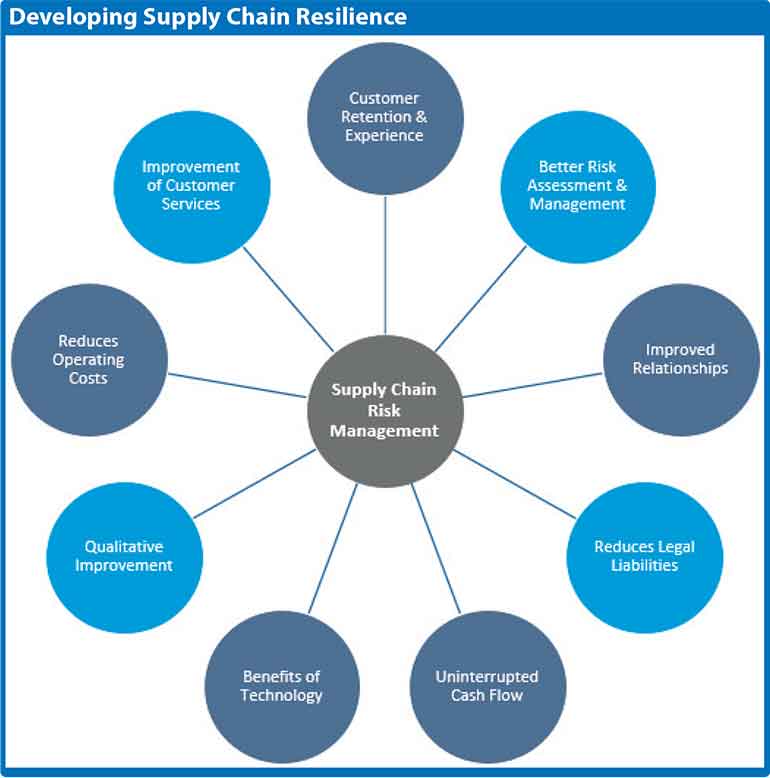Tuesday Apr 22, 2025
Tuesday Apr 22, 2025
Tuesday, 22 April 2025 02:18 - - {{hitsCtrl.values.hits}}
Across nearly every industry, an organisation’s supply chain is its lifeline. It plays a key role in ensuring productivity, profit and business continuity. Consequently, an enterprise’s safeguarding of its supply chain is of paramount importance to minimising risks to its financial success, reputation and operational performance.
 An organisation’s supply chain vulnerabilities increase not only depending on transactions with clients and any outsourcing to vendors, but also during times of uncertainty. Several factors from globalisation to high demand and supply, and the business demands of other organisations, also influence the workings of supply chain management. It follows that, as technologies develop and advance, mitigation strategies are equally required to evolve and reinforce enterprise infrastructures to prevent collateral damage. This process of adapting to identify vulnerabilities is known as Supply Chain Risk Management (SCRM).
An organisation’s supply chain vulnerabilities increase not only depending on transactions with clients and any outsourcing to vendors, but also during times of uncertainty. Several factors from globalisation to high demand and supply, and the business demands of other organisations, also influence the workings of supply chain management. It follows that, as technologies develop and advance, mitigation strategies are equally required to evolve and reinforce enterprise infrastructures to prevent collateral damage. This process of adapting to identify vulnerabilities is known as Supply Chain Risk Management (SCRM).
Once recognised, the next step in addressing and mitigating of risks requires a comprehensive review of logistics, supplier relationships and overall operational strategy. Many companies are turning to technology to aid in risk assessment. Software platforms are rapidly developing accessible and scalable means of analysing data trends to better facilitate decision-making. The predictive analytics of these technologies pose a range of advantages because of their ability to forecast potential disruptions, giving businesses a game changing head start in planning effective contingency plans and response strategies.
Some key statistics to note:
Key Challenges in Supply Chain Risk Management
As the world looks to the future, several challenges are shaping the landscape of risk management strategies in supply chains.
Increased Complexity of Global Supply Chains
The growth of global trade has led to more complex supply chains, making them harder to monitor and manage effectively. Multiple points of failure exist. As a result, acquiring real-time visibility into these networks remains difficult.
Data Overload
In an age where data is available in abundance, determining what is relevant can be overwhelming. Companies must invest in systems that can filter and analyse critical information without succumbing to the noise.
Sustainability Pressures
With a heightened focus on corporate responsibility and sustainability, companies face pressure from consumers and regulators alike to reduce their environmental footprint. This can put a strain on cost efficiency.
Talent Shortages
A shortage of skilled professionals in supply chain management can impede the ability of organisations to innovate and respond proactively to risks. Retaining and developing talent internally is more critical than ever.
Regulatory Changes
Constantly shifting regulatory environments can make compliance a moving target, adding stress to supply chain operations. Businesses need to stay abreast of these changes to mitigate legal risks.
Developing Supply Chain Resilience
A key component of effective SCRM lies in the application of robust quantitative models. These models provide a structured framework for analysing potential risks, assessing their impact and developing data-driven mitigation strategies.
Although the current SCRM models offer a useful starting point, innovation is always required. By incorporating statistical analysis, simulation techniques, and optimisation algorithms, businesses can gain a deeper understanding of their supply chain vulnerabilities and make informed decisions to enhance resilience.
It is essential to create new models, specifically made to handle the unique challenges of modern supply chains. Global interconnection, ongoing technical developments and growing geopolitical unpredictability are some of the elements that these models ought to consider. Additionally, both the accessibility and scalability of these models is a requirement to ensure companies may easily incorporate them into their current risk management procedures.

Embracing Effective Strategies
In order for organisations to navigate the complexities of supply chain management in 2025, they will need to be agile and forward-thinking in the application of SCRM. By identifying the main challenges and adopting strategic solutions, businesses can not only reduce risks but also excel in a rapidly evolving global market. The insights gained from recent global events can inform future strategies, highlighting the significance of resilience and adaptability.
To conclude, the essential message is to invest in technology, cultivate adaptable strategies, emphasise the need for cybersecurity, promote sustainability, and develop talent. Organisations need to embrace transformation. In doing so, they will not simply endure but thrive in the constantly shifting realm of supply chain management.
Footnotes:
1 2023 Deloitte Global Supply Chain Survey
2 Based on a 2022 survey of 1,300 companies by the Business Continuity Institute
3 Resilinc
4 Dun & Bradstreet
(The writer is the Director of Cybersecurity at Sysco LABS and Business Security Officer – APAC, Sysco. She leads the Security Operations Center at Sysco LABS Sri Lanka. Shanthi has over 21 years of experience successfully spearheading IT security program initiatives for organisations like Fidelity, IBM, Wells Fargo, and Barclays in the banking sector. She holds a Bachelor’s Degree in E & C Engineering, a Master's from Symbiosis and is currently pursuing a PhD from the University Grants Commission of India; her research focuses on innovative approaches to safeguarding sensitive information, aiming to address emerging challenges in the field.)